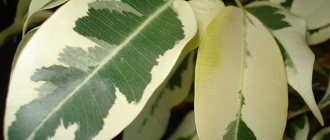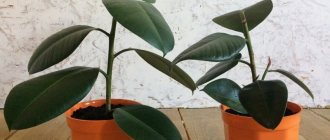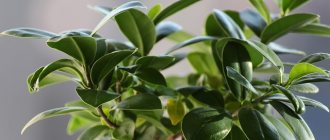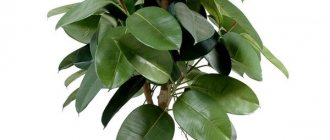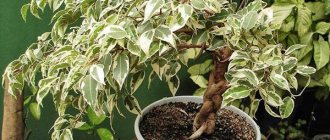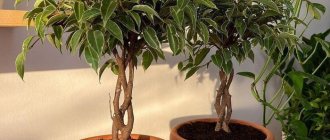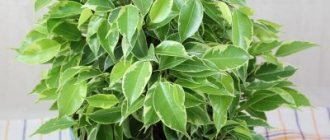The small-leaved shrub Ficus Benjamina is a member of the Mulberry family. It is very popular among flower growers. Moreover, the plant received its name in honor of Jackson Benjamin Daydon, a botanist from Spain. However, many people mistakenly believe that it was named after American President Benjamin Franklin. This plant is distinguished by its unpretentiousness, but it is worth paying attention to the fact that the first 3 months of life in a new place are the most difficult for it. If during this time the ficus does not get sick or die, this means that caring for it in the future will be relatively simple.
Ficus benjamina indoors - description
Ficus benjamina belongs to the genus Ficus of the Mulberry family. This evergreen plant is an elegant tree or shrub with small leaves and thin slender stems. In the wild it grows in Asia and northern Australia, preferring to settle in damp forests and foothills.
The height of Ficus Benjamin can reach 30 m, but at home it rarely grows more than 2 m. There are also more compact varieties up to 50 cm in height. At the same time, the growth rate of this species is not rapid, but a home tree can easily add about 20 cm in a year New branches appear from any dormant bud on the trunk and branches, creating a lush and beautiful crown.
The trunk of Ficus Benjamin is slender and graceful. The stem and branches of the plant are covered with thin light brown textured bark. Typically the plant forms only one trunk with many thin and flexible branches. This feature gives Ficus benjamina a resemblance to a birch tree, which is why people have given it the affectionate name “Ficus birch”. The branches of the plant actively branch and are densely covered with beautiful leaves.
Benjamin leaves are small, thin, oval-shaped with a pointed end. The color of the leaves can be very diverse. In nature, the color range of leaf blades of this species is represented by dark shades of green, but varieties of Ficus benjamina can boast a wider palette of shades. Various varieties with leaves of light green and light green, decorated with spots and veins of yellow, cream and white colors are very popular among gardeners.
At home, Ficus Benjamina does not form aerial roots, but in the wild, their roots are so numerous and bizarre that they form entire thickets in which an adult can easily walk. Such trees are called banyan trees and they look really impressive.
Does it bloom?
Few gardeners have ever seen Ficus Benjamin bloom. This plant is valued for the beauty of its crown, but in nature or special greenhouses it may well please with its flowering. The flowers of this tree resemble round peas in appearance and are called syconia. They form at the ends of branches and are a great test for a weakened tree, so in greenhouses and winter gardens they prefer to simply remove the inflorescences that appear.
How many years does he live?
The homemade Ficus Benjamina can live more than 15 years, but in nature the age of some of its specimens is many decades. With proper care, this spectacular tree can live for a very long time and even be passed on to future generations.
Happiness in your home - ficus "Balsamina"
Even if indoor flowers are not of particular interest to you, ficus plants are probably very familiar to you.
It is impossible to find two identical representatives of this genus, because each owner tries to make something special from his tree or vine.
Even the popular Benjamin ficus (often mistakenly called Benzamine, Benjamin or Balsamina) has up to 20 species, including Natasha, Starling, Verigate and Navali.
…
Origin story
The homeland of ficus benjamina (subgenus Urostigma) is considered to be India, the countries of Southeast Asia, and the Philippines.
Under natural conditions, this evergreen (there are deciduous species) plant reaches a height of 20 meters, is very hardy, and is not afraid of temperature changes, winds, or heavy rains.
But as an ornamental tree, it is more delicate, whimsical and requires serious care.
Benjamin can begin its development both as an ordinary tree and as an epiphyte, the roots of which, after a certain period of time, reach the soil and take root, giving life to several shoots.
Gray smooth bark with thin streaks, a wide crown and thin shoots with drooping leaves.
Not every gardener manages to see the fruits, which are called syconia, but if your ficus has bloomed, then paired fruits will soon appear on it, tightly adjacent to the shoots, which grow up to 2 cm, when ripe, they become burgundy and inedible.
Home care
Ficus balsamina requires special care at home. The plant does not tolerate changes in environment well, stress can destroy it.
Transplant the tree into a permanent container, at the bottom of which drainage is poured, and then a mixture of turf, sand and peat. Pour in cool water.
Carefully monitor Benjamin for 3 months, during which there is a risk of death of the young tree. It may shed its leaves and slow its growth while it recovers.
Do not water it too often, it is better to spray it 2 times a day. It is necessary to shed the soil well only when the soil is dry.
Sometimes the seedling is covered with a glass jar or plastic bag, opening slightly only for ventilation. The ficus is kept in the greenhouse for about a month.
After 20-30 days, you can feed the ficus with “Rainbow” or a special complex for palm trees.
Watering
Water the ficus with settled water at room temperature. While the tree is growing and gaining strength, abundant watering is needed.
In spring and summer, you need to not only water, but also frequently spray the leaves.
In autumn and winter, watering is reduced to 2 times a week, while continuing to care for the foliage.
Bloom
An extremely rare phenomenon at home, benjamin fruits, unlike some “relatives”, for example, figs, are inedible.
Crown formation
The formation of the ficus crown is a matter of your taste. Several shoots look great, braided into a braid, the top of which is decorated with a ball of green foliage.
Bonsai enthusiasts remove shoots as much as possible to achieve fine foliage and good branching.
You need to start forming by trimming the central shoot into 3 buds.
If you are simply forming a crown, then trim the branches every spring; bonsai requires more frequent pruning, which the ficus easily tolerates.
Treat the cuts with pitch or ash to prevent juice from leaking out.
The soil for ficus benjamin needs light, well-saturated with oxygen. It is best to use a mixture of peat, sand and turf.
Planting and transplanting
Planting features are different for each species. But, as a rule, Benjamin cuttings are rooted in small containers filled with sand, maintaining constant humidity.
It is best to create greenhouse conditions for the young shoot by covering it with a glass jar.
The ficus takes root for 1 month, then it is transplanted to a permanent place.
Ficus trees are replanted annually for up to 3 years, in early spring, when active growth has not yet begun.
A lump of earth, entwined with roots, is removed from the old pot and placed in a larger one, in which fresh drainage and soil mixture are poured.
Adult ficuses are replanted only when the previous container has become too small for the roots, but the top layer in the container is changed annually.
Photo
In the photo there is a ficus balsamina:
Reproduction
Ficus is propagated by cuttings obtained by pruning. The twigs are placed in jars with Kornevin and wait for the roots to appear.
Then the ficus is planted in sandy soil or a special mixture.
If the plant has lost its leaves or is too old, you can cut off the bark around the top, leaving 10 centimeters for the cutting.
Tip: Make the incision no more than 2 cm.
After 14 days, aerial roots will appear near the cut: now the cutting can be separated from the mother tree and planted in the ground.
Temperature
Ficus benjamina loves bright, diffused light; the temperature during the growth period (spring and summer) should be about 25 degrees; at higher temperatures it sheds its leaves.
Ficus overwinters at a temperature of 17 - 18 degrees. Some varieties, such as Natasha, like high humidity and higher temperatures.
Important: if your handsome plant has variegated foliage, spray it daily, make sure that the temperature does not drop below 20 degrees, and take it out into the fresh air in the summer.
Benjamins are man's most faithful friends. They purify the air, saturate it with oxygen, and release biologically active substances that increase performance and normalize sleep.
Ficus leaves help with rheumatism, accelerate wound healing, and relieve inflammation.
Milky juice is useful for skin diseases. A decoction of the roots is taken for diseases of the genitourinary system.
Interesting: our grandmothers recommended growing ficus to infertile couples.
It was believed that this plant not only brings peace and happiness to the home, but also promotes procreation.
The ficus can only harm its neighbors on the windowsill: a rapidly growing tree gradually displaces everyone.
If your ficus is not a bonsai, look for a comfortable, well-lit place on the floor without drafts, and it will become a real decoration of the room.
Scientific name
The genus Ticus (Ficus) was isolated in the mid-18th century by Carl Linnaeus.
In his “Types of Plants” he described several species, among which was the biblical fig tree.
Ficus benjamins have many names.
The most common of them:
- Focus benjamina;
- Benjamina free;
- Benjamina fig;
- Danielle;
- Exotica;
- Monique;
- Barok;
- Natasja.
Interesting: During the time of Alexander the Great, botanical descriptions were compiled of a gigantic, powerful Ficus tree with a round crown, under which an entire detachment could be accommodated, because its shadow fell 300 meters.
Ficus benjamina is a symbol of the city of Bangkok.
Ficus, the “turtle” plant, grows in Sri Lanka. This is how the tree was named because its crown resembles an animal.
“Turtle” is more than one hundred and fifty years old, the crown of the tree is 2500 square meters.
Diseases and pests
Ficus trees are very disease resistant. The most dangerous period for them is the first three months.
Among the pests that are dangerous for ficus are aphids, spider mites, and shield aphids.
Carefully and carefully wash the leaves with a soapy solution, to which you can add tobacco dust, chamomile, and calendula.
Wipe the leaves to remove insects. Do not forget to constantly spray the plants, this is the best prevention.
Are your ficus balsam leaves falling?
When overmoistened, a sudden change in temperature, or drafts, ficus plants lose leaves. Follow all the rules for growing and caring for this plant, do not allow the soil to become waterlogged or dry out to prevent this from happening.
But what if all the rules are followed and the leaves fall? Don't worry, sometimes this is a completely normal, natural process. For example, trees lose leaves on the lower part of the trunk, as in nature.
Conclusion
A favorite houseplant for centuries, ficus benjamina is a well-studied and not too fussy plant. They look great in an apartment, cottage, or office.
With careful care, you can grow a real work of art, and if cutting and experimenting is not your thing, just... talk to Benjamin when your heart is heavy. They are excellent companions for introverts and melancholic people.
selo.guru
How to care for ficus benjamina at home
Flower growers fell in love with Benjamin for his simple character. If you follow a few rules, this plant will be a worthy decoration for your home’s green corner.
Lighting
Ficus benjamina requires plenty of sunlight when growing, but the plant does not tolerate direct sunlight. It can be placed on the windowsill of an eastern or western window, and larger specimens can be placed near southern windows. On a northern window, due to lack of light, growth slows down and the crown thins out.
Varieties whose leaves are decorated with many light spots require much more light, otherwise they will begin to lose their beautiful color. Such specimens may require additional lighting with fluorescent lamps or special lamps for plants.
Temperature
The Benjamin tree is quite thermophilic, but can easily grow at normal room temperature. The optimal maintenance temperature in the warm season is about +18-+250C. In winter, the temperature in the room should not fall below +160C. The plant does not tolerate drafts, so to prevent the flower from freezing, it is taken to another room during ventilation, since the plant sheds its leaves when exposed to cold air.
It should be borne in mind that variegated varieties of Ficus benjamina need warmer maintenance and are extremely critical of temperature changes.
Humidity
The room where Ficus benjamina grows should have high humidity. It can grow at normal humidity typical of a living room, but you need to regularly spray the crown with warm water from a spray bottle. The leaves of the tree dry out from the hot air when heating devices are operating, so in winter it is removed away from the radiators. You can increase the humidity using a household humidifier; you can also place a flower pot on a tray with expanded clay or wet moss.
Watering
Water the Benjamin tree abundantly, but without allowing the substrate to become waterlogged. Water for irrigation should be soft, at room temperature.
In summer
In the warm season, water every 3-4 days. Watering should be plentiful, as the contents of the pot dry out 3 cm deep. The earthen ball should not be allowed to dry out, as in this case the growth of Ficus Benjamin will stop and it will begin to lose leaves.
in winter
In winter, watering is reduced to moderate. The soil in the pot is moistened approximately once a week, as the top layer dries.
Fertilizer and feeding
From March to October, Ficus Benjamina needs special feeding. Fertilizers are applied 2 times a month, and you can use complex mineral fertilizer or alternate it with organic matter.
When choosing a preparation, it is important to pay attention to the ratio of components, since a high nitrogen content can lead variegated varieties to a completely ordinary monochromatic appearance and loss of characteristic spots. In flower shops you can find special fertilizers for ficus plants. Agricola for Ficus benjamina can be an excellent feeding option. It is used according to the instructions, strictly observing the dosage.
Fertilizers can be applied to the soil or on the leaves. For this you can also use special preparations and mineral fertilizers, but in weaker concentrations.
Special feedings will help not only stimulate the growth of the flower, but also help it recover after a change of place of residence or illness. In order for the plant to better withstand stress, it is sprayed and watered with succinic acid or epin. Succinic acid for Ficus Benjamin serves as a good antidepressant and helps to recover, even if it has lost most of its leaves. It is diluted with water and applied along with watering or sprayed on the crown in a more reduced concentration. After some time of this “therapy”, the ficus comes to life again and begins to actively grow green mass. How to breed Epin for Ficus benjamina can be found in the instructions. This drug has a complex effect and is used for many indoor and garden crops. Just 3-4 drops per 1 liter of warm water are enough to water the bush, after which it regains its vibrant appearance and gradually regains its attractiveness.
Pruning and crown formation
Ficus benjamina lends itself well to pruning and crown shaping. You can create a beautiful shape simply by periodically removing overgrown branches. Usually the plant is given the shape of a lush bush, every spring shortening the main branches to 15 cm and the side branches to 10 cm. The bush will quickly restore its shape and begin to actively increase the lost volume. All branches growing inside the crown are pruned so as not to disrupt air circulation.
To give the Ficus benjamina the shape of a beautiful tree, remove all the side branches on the main trunk. For uniform development of the crown, you need to periodically turn the flower pot in relation to the light source, then the ficus will develop evenly on all sides.
If you need to stimulate the growth of lateral branches on the trunk, you can resort to a little trick and use special means. Cytokinin paste for Ficus Benjamin serves as a stimulator for the awakening of dormant buds. She does an excellent job even if the bush has been significantly damaged by a draft or improper care. To do this, just make small cuts on the trunk of the plant and apply a small drop of paste onto them with the tip of a toothpick. After some time, new branches will begin to appear on the trunk. Just keep in mind that cytokinin paste stimulates the growth of new shoots, but in order for them to grow and develop well, the plant must be well fed and provided with everything necessary for vigorous growth, otherwise new branches will grow disproportionately and may disrupt the decorative appearance of the Benjamin tree. Also, when using special means in variegated varieties, new branches often grow with monochromatic leaves.
How to braid a trunk
The thin and graceful stems of Ficus benjamina are often used to create real living sculptures. The beautiful columns of intertwined trunks of this plant look very attractive, while the ficus does not suffer at all and continues to grow. Weaving Ficus Benjamin is not a complicated process, but it requires a lot of patience, since the formation of an openwork trunk does not occur in a few days, it will take months and even years.
To do this, you need to take several ficus cuttings and plant them in one pot. The planting density depends on the desired result: if you need to tightly intertwine the stems to get a tight twisting trunk, then the seedlings are planted close to each other, at a distance of only 5-10 cm, and when creating an air column, the distance can be increased.
As the seedlings grow, they are braided, secured with plaits and tied with electrical tape. Tightly planted plants are carefully twisted in a spiral and secured. Over time, they will grow together into one dense and beautiful trunk.
Openwork columns are created by crossing and securing young ficus trees. In the middle of the plantings, it is advisable to place a pipe made of plastic or cardboard, around which patterns will weave. In this case, you need to constantly remove all excess lateral growth, leaving leaves and twigs on the crown. The stems are crossed at the desired distance from each other and secured with strands. After they grow together, the tourniquets are removed. For such a composition, it is advisable to plant at least 5 seedlings. More complex and beautiful ornaments are obtained by using 8-10 young plants.
Interesting varieties
The species Ficus benjamina is one of the most extensive, many varieties belong to it. The most common varieties have a single trunk, although varieties with intertwined, branched trunks or a shrub-like crown are also quite common.
Ficus benjamina "Natasha" is very durable and easy to grow and care for. The plant has small dark green leaves and rather flexible woody stems. At home it grows up to 3-4 meters! Fans of shorter specimens can grow them as bonsai. This is an extremely “plastic” plant - it can be trimmed in any way you like, creating different shapes. The flower cleanses the air of toxic substances (formaldehyde, benzene).
Requires location in slightly indirect sunlight, not direct sunlight. The room temperature should not fall below 13-15 °C. Watering is carried out with soft water when the substrate dries - in the summer 2 times a week, in the winter - 1 time a week (excess water must be drained from the stand). Loves spraying with water and cleaning leaves. It is recommended to fertilize once a month in the spring and summer. Photo. Variety "Natasha"
The Anastasia variety is popular with beautiful, slightly shiny leaves with lighter edges and a soft crown shape.
The natural species has green leaf blades, but varieties of Ficus benjamina with two-color leaves are often found:
- Ficus "Kinky" Benjamin (lat. Kinky) is characterized by slow growth and variegated leaves with a light green color. This is the most famous variegated ficus of small-leaved species. Don’t be confused, there is also a variety with solid green leaves, Ficus “Green Kinky” Green Kinky.
Photo. Ficus "Kinki"
- Ficus "Starlight" Starlight is a variety with golden-variegated leaves. Loves positions with diffused light, moisture in the substrate, and spraying. Requires a lighter position than the natural species due to the smaller area of leaf assimilation.
- "Variegata" Variegata is a variety with creamy-green leaf blades.
Also interesting is the Exotica variety - green leaves have long curled tips.
Ficus Benjamin "Daniel" has no special care requirements. A light position is required for lush growth. Sensitive to temperature changes and drafts. Under favorable conditions it grows to a height of 5 m; young plants need support. When grown at home, it can reach 200-300 cm. Watering should be done moderately. We recommend fertilizing during the growing season (spring, summer). This is the most famous variety of small-leaved species. The main decorative element of the plant is dark green leaves, densely covering the hanging branches.
Reproduction
It is quite easy to propagate Ficus benjamina at home. To do this, just cut off a small branch and root it in water, and then plant it in the substrate. You can also use the layering method, and enthusiasts can try to grow beautiful and rare varieties from seeds.
Cuttings
Cuttings are the easiest and fastest way to get a new bush. To do this, separate a twig 8-10 cm long. It is advisable to choose not young green twigs, but semi-lignified ones. Drops of milky juice are removed from the cutting site, the cuttings are placed in a glass of water and covered with a transparent cap. As a rule, after 1-2 weeks the first roots will begin to appear. When they grow to 5 cm, the seedlings are planted in a pot with substrate.
By layering
A small circular cut is made on a bare branch, wrapped in damp moss, and covered with a transparent film on top. The film is secured at the top and bottom with thread or soft wire. From time to time you need to moisten the moss; to do this, open the film from above and drop a couple of drops of water under it. As roots begin to appear on the stem, the branch is cut off and rooted in a pot with substrate.
Seeds
New varieties of Ficus benjamina can be grown from seeds. To do this, the material is pre-soaked for a day in warm water, then sown in a peat-sand mixture. The seeds are planted to a depth of 0.5 cm, sprinkled with earth, covered with film and placed in a warm, bright place. For germination, seeds are kept at a temperature of +25-+270C. The film is removed daily for 10-15 minutes, the greenhouse is ventilated and, if necessary, the surface of the substrate is moistened with a spray bottle. When the first shoots appear on the soil surface, the film is removed. The seeds may take about 2-3 months to germinate, so you need to be patient. After the seedlings hatch and grow a few leaves of their own, they are transplanted into small pots with suitable soil.
Ficus benjamina transplant
In order for Ficus Benjamin to grow well and develop normally, we must not forget about regular replanting. To prevent the plant from experiencing severe stress, it is transferred from the old pot to a new one without shaking the earthen ball. During planting, a drainage layer of pebbles, expanded clay, and small stones must be placed at the bottom of the pot. During transplantation, the plant is placed in a pot and the remaining space is filled with soil mixture, a little soil is poured on top, but the root collar is left at the same level.
When to replant
Benjamin is replanted in the spring. For the first 4 years, plants are replanted annually, and after that only once every 2-3 years.
Priming
Full growth and development of a plant is impossible without a high-quality substrate. You can purchase a special soil mixture for ficuses in the store, but if desired, suitable soil can be prepared from equal parts of sand, peat, turf and leaf soil. A little charcoal is added to the finished substrate.
Pot
A pot made of any material will do. It can be ceramic or plastic, but there must be a sufficient number of drainage holes at the bottom of the container. A pot that is too high may be unstable and will tip over, so the new planting container should be 2-3 cm wider than the previous one.
Lighting and temperature
The plant needs to be provided with bright, diffused light .
Ficus feels comfortable in an apartment, but it should be noted that the temperature should not be lower than 17 or higher than 30 degrees.
In winter, you need to place it away from radiators, since the plant does not tolerate too high temperatures, and in summer, avoid direct sunlight. In addition, drafts should be avoided.
Diseases and pests of Ficus Benjamin with photos and their treatment
In general, Ficus benjamina is quite hardy and, with proper care, rarely suffers from diseases and pests.
If not properly cared for, the bush can be attacked by scale insects, spider mites, mealybugs or aphids.
Aphids on Ficus benjamina attack young leaves and growing points. This pest forms entire colonies and sucks juices from young branches. You can get rid of aphids by washing with soapy water and treating with special insecticides.
Spider mites on Ficus benjamina appear in dry indoor air. The infected plant does not grow, begins to wither, turns yellow and drops its leaves. The first thing to do when you find cobwebs on your Ficus benjamina is to increase the humidity in the room. To do this, install a humidifier, vessels with water nearby, or sprinkle with water mist. Spraying with a soap solution, Aktara or Aktellik will help get rid of pest colonies. Afterwards, the bush is covered with a transparent cap or bag and ventilated daily.
Sticky leaves indicate a scale infestation. A related problem may be sooty fungus, which is very fond of the sweet secretions of this pest. The infected plant is washed with soapy water and treated with Actellik.
White lumps at the base of the leaves may indicate a mealybug problem. This pest has a small body, as if covered with cotton wool. How to deal with mealybug on Ficus benjamina:
- Remove white spots on the leaves of Ficus benjamina using a soft sponge soaked in soapy water.
- Treat all parts of the plant with soapy water.
- Treat with insecticide.
After this, you can trim the bush, and when it is completely restored, then spray it with epin or succinic acid.
Among the diseases, anthracnose, powdery mildew and root rot can be dangerous.
Anthracnose in Ficus benjamina can be recognized by the red spots on the edges of the leaf blades. Afterwards, the leaves become covered with holes and die. The plant is treated with special fungicides.
Powdery mildew on Ficus benjamina appears as a white coating on the leaves and branches. It is difficult to fight the disease; it is easier to cut off all infected parts and treat the plant with a fungicide.
When root rot occurs, the entire plant withers, turns yellow and loses its foliage. In this case, it is removed from the pot, cleared of soil and all affected parts are removed. After this, the plant is planted in a fresh substrate and treated with fungicides.
The following difficulties may also arise:
- The leaves of Ficus Benjamin turn black due to poor watering, low humidity in the room or an incorrectly selected substrate.
- The leaves of Ficus benjamina are drying due to dry air.
- Spots on the leaves of Ficus benjamina - yellow and brown spots on the leaves indicate too much light and exposure to direct sunlight.
- Leaves curl and wither - a draft or low temperature in the room.
- Thin and weak shoots - lack of light and nutrition.
With regular inspection of the plant and compliance with the rules of care, the house ficus will grow for a long time and delight its owner. A sudden change in living conditions can cause stress in the plant, so at first it can be sprayed with a solution of succinic acid or epin.
Ficus balsam leaves have turned yellow and are falling off - what’s the problem? thanks for answers!
balsam If the temperature is too high and there is a lack of moisture, the leaves may droop somewhat. To avoid this, the plant must be watered more often, but not kept in a pan of water all the time. Excessive waterlogging is detrimental to the plant. Due to prolonged cold conditions and excess moisture, as well as from pest damage, the leaves turn yellow and fall off, and a fluffy gray coating may appear on the inflorescences - gray rot. Excess moisture, especially at low temperatures and insufficient lighting, can cause rotting of the base of the stem and roots. If the air is too dry and hot, there is a lack of light and excessive feeding, or if the content is too cold, the buds and flowers fall off. In dry rooms or when the soil dries out, flowers fall off. With constant overdrying of the substrate, fewer buds are formed or not at all. Variegated forms lose color when there is insufficient lighting. If kept too cool and not enough light in autumn and winter, plants lose leaves and stop blooming. The stems are elongated, the leaves are small and pale - when there is a lack of nutrients in the soil, or when the pot has become cramped, as well as when there is insufficient lighting. In addition, most types of balsam are characterized by rapid growth, causing the plant to stretch, the stems at the base become bare, and the decorative appeal is lost. High temperatures (above 22°C) contribute to this. Therefore, it is advisable to renew balsam in the spring by cutting and rooting several young cuttings in one pot. The stems rot, the leaves curl, and fall off if it is too cold and damp. This can happen if the plant is placed in the garden in the summer, with the onset of cold rainy nights. Flowering is weak or absent - the reason may be a lack of light, a lack of nutrients in the soil or an excess of fertilizer (as well as improper fertilizing, for example, nitrogen fertilizers). Unexpected flight of flowers and cessation of flowering can be caused by a sharp cold snap, severely dry soil, transplantation into a pot that is too large, or transplantation carried out at the wrong time. If the temperature is too high and dry in winter, it can be affected by red spider mites, and the leaves turn pink and become spotted. Aphids and whiteflies are also dangerous.
Damaged by: spider mites, aphids, whiteflies.
Oak leaves are falling from the ash tree - that's a damn thing!
Ficus Benjamina did you mean? Most likely it was overdried or overwatered.
I think it is possible to help your ficus, although it will take a long time. To begin with, water it once a week for a month with a solution of the drug Kornevin to stimulate root formation. Spray the leaves with Epin 2 times a week (if not all have fallen off). It is useful to feed the plant in the autumn-winter period with Orton Growth 2 times a week. To increase the air humidity in the apartment, place the pot on a tray with damp moss or expanded clay.
Good luck to you. Source: From the Internet
In autumn, when the days become shorter and the light levels drop, Benjamin's ficus often sheds a lot of leaves. He loves good light, constant location and temperature. As soon as the leaves begin to fall, or better yet, at the end of September, without waiting for the leaves to fall, move it to the brightest place. It is also afraid of drafts.
Veta wrote to you on how to restore your flower.
1. In Ficus Benjamin (like many other plants), some leaf fall is a variant of the norm. 2. The plant can shed its leaves en masse in cases of adaptation to a new place (if you just purchased it; or moved it to another place in the apartment)
3. Maintenance problems: improper watering, for example
ficus benjamin probably...
fall from a draft, from overflow, from drought, look for the reason
Ficus Benjamina is correct. They fall off due to draft, cold, flooding or underfilling.
Don't breathe garlic on him!
indoor-plants-tips.ru
Ficus benjamina - popular varieties with photos and names
Ficus benjamina is very popular among flower growers, and therefore is of great interest to breeders. As a result of selection, on store shelves you can find a huge number of cultivated varieties with very different bush shapes and leaf colors.
Natasha
Dwarf Ficus Benjamin with a lush but compact crown and small variegated leaves. The leaves of the variety are dark green with cream spots and a border.
Kinky
The foliage of this variety is dark green with light edges. The leaves are small, up to 5 cm in length. The crown is lush, but requires regular pruning.
Daniel
The leaf blades of this species are shiny and dark green. The edge of the sheet is smooth.
Dunetti
Ficus with beautiful small heart-shaped leaves. The stems are drooping, so several bushes are often planted in one pot so that they can keep their shape.
Starlight
A variety with dark leaf blades and light cream spots along the edges.
Golden King
The leaf blades are painted a light shade of green with a white edge.
Anastasia
A variety with dark green leaves, decorated with a light green border and vein.
Esther
The leaves are light green, smooth, shiny.
Exotic
The leaves are dark with a wavy edge.
Baroque or Curly
Ficus leaves are light green, twisted into beautiful rings.
Twilight (Twilight)
A variegated variety with a dark green leaf plate, decorated with a white border and streaks of light green and white. In bright light, the color of the leaf can change to almost white.
Nina
Small-leaved ficus with a lush crown. The leaves are narrow, gray-green, decorated with a thin yellowish border.
Golden Monique
A variety with thin drooping branches and elongated leaves with a wavy edge. The foliage color is golden-green with a prominent central vein.
Reginald
The leaf blades are light, with dark spots in the center.
Safari
A plant with small boat-shaped leaves. The color is marbled, combining dark green and frequent strokes and streaks of cream color. In bright light, the bush acquires a more variegated color, and some plates become almost completely white.
Curly
A variety with small leaf blades slightly wavy along the edge. The main color is dark green with small specks or large spots of white. Some of the leaves of this Ficus benjamina are white and completely devoid of chlorophyll.
Photo
In the photo there is a dwarf ficus:
Ficus can complement any interior and bring comfort to the atmosphere of the home. Read about growing such varieties of this plant: De Gantelle, Amstel King, Ampelny, Carica, Benedicta, Ginseng, Moklame, Eden and Bengal.
What Ficus Benjamin brings to the house: signs and superstitions
There are many superstitions associated with Ficus Benjamin. If in the East this plant is considered to be a symbol of wealth and prosperity, then in Russia and the CIS countries the ficus is called “muzhegon” and is credited with magical properties that have a negative impact on family members.
In China, Ficus Benjamin is given as a wedding gift and passed on from one generation to another, and in some Eastern countries this beautiful tree is considered sacred. At home, ficus is able to absorb negative energy, attract wealth into the house and help in amorous matters. If you give Ficus Benjamin to a childless couple, they will soon have a child.
But in order for this tree to have a positive effect on the “weather in the house”, it must be placed correctly:
- Kitchen - wealth and relief from financial problems.
- Office - good luck at work and increased productivity.
- Bedroom – improved sleep, relief from anxiety and quick pregnancy.
You should not place a pot of Ficus benjamina on the north or west side of the house. Then the plant will not have enough sun, and it will not be able to influence the microclimate in the family.
In any case, everyone decides for himself whether to believe or not to believe in various superstitions. But in any case, if this beautiful and lush tree appears in the house, the room immediately transforms and becomes more comfortable.
Watering
This plant does not have any strict watering schedule , since many external conditions influence its water consumption.
The best way to determine when it's time to water is to test the soil. If the top layer has dried out by 3-4 cm, then it’s time to water it.
It is also worth keeping in mind that ficus tolerates slight drying out more easily than excessive amounts of moisture. Therefore , it is better to water it in several stages so that the moisture is evenly distributed throughout the earthen coma. Excess moisture remaining in the pan must be drained to prevent the possibility of root rotting.
The main condition is to prevent both excess moisture and excessive drying of the soil.
When watering, it is best to use settled water, the temperature of which is slightly higher than the temperature of the room where the plant is located. Failure to follow these rules can lead to Benjamin's ficus shedding its leaves.
Photos in the interior
Ficus benjamina is a luxurious spreading tree that attracts attention with the elegance of its branches and the density of its crown. With proper care, the ficus birch tree will become a real decoration for your home collection, capable of refreshing the interior of a city apartment even on its own.
Caring for Ficus Kinki
Ficus is easy to care for, but several conditions must be observed:
- The room in which the Kinki ficus will grow should be well lit.
- You need to decide in advance where you will place the plant, so as not to rearrange it in the future.
- It is necessary to ensure timely watering.
- It is necessary to replant the plant on time.
- In the autumn-spring period, fertilizing is required.
If not properly cared for, the ficus will begin to shed its leaves.
